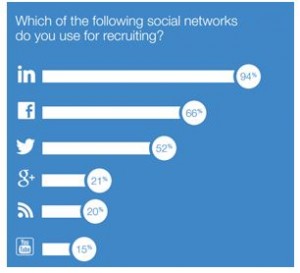Social media recruitment in HR – why should you care?
Because, like the Gen-Y so daintily put it, ‘Social media is the bomb’.
HR experts and recruiters herald it to the next best thing, since sliced bread (read: spread sheets). So you know it can give the best and the most explosive bang for the buck.
| Only 18 % think that they are experts in social media hiring. What about the rest? |
92% of companies use social media for recruitment and 42% companies report that candidate quality improves with social recruitment. They seem to see an increase in candidate quality, quantity and time to hire. And what’s more, the percentage of companies willing to use social media arrow in their recruitment quiver only rises.
Then why is it that every time you try to use these platforms, for recruitment, the returns don’t justify the spend? What is it that others do right that works for them, but to you it appears like a game of chance – a hit & miss?
What is Social Media Recruitment?
Simply put, this is a means of leveraging social media platforms to drive the best talent to join your company. Here social platforms double as a talent database or platform for advertising.
Though millennials are thought to make up for the largest chunk of social media users, the baby boomer generation and Gen-X are increasingly becoming active. The fastest growing demographic on Google+ is 45-54 and on Twitter it is 55-64! This presents a huge opportunity for recruiters to reel in all kinds of talent.
More Science and Less Chance

You cannot be the brand that posts one vacancy once in three-five months and hope for a tsunami of interest from followers. To gain interest on social media, a sustainable and measurable level of activity is essential.
To ensure that your organisation bags top talent, across generations, you need to be able to crystallize on a solid social media strategy, based on empirical scientific evidence. This should be followed by a series of trails and experiments to arrive on a social media recruitment theory that best suits your company.
Here are some elements that are key to ensure that the social media strategy is fool-proof:
- Understand your social media channels: The study of social media trends will help you understand which channels you need to focus more attention on and how.

- Analyze your Audience: Every social media channel hosts audiences with varied demographics, at different levels of their career and/or mental maturity. It is therefore up to you to customize your messages to appeal to potential candidates on each platform.For instance, the most rapidly growing demographic on Twitter is the 55–64 year age bracket. You need to understand what percentage of your followers make up for this segment of the population and mold your strategy against their sensibilities.
- Reflect corporate culture on your social-media page: All companies with social media pages need to have a consistent tone, which reflects the corporate culture. A recent survey concluded that 85% managers want candidates who have the right attitude (cultural fit).
This is why you see companies that are great at social media recruitment often have a personality that shines through in their e-communication. You can even have senior managers at your firm; write engaging posts that connect with readers. This helps you attract candidates who are the right fit for your company culture. - Maintain a good online reputation: Social media reviews can break or make a company’s image. Research reveals that over 80% adults use reviews before making a decision. Be it Glassdoor reviews, Linkedin discussions or twitter conversations; you need to ensure that your company is presented in the best light, at all times. Therefore there is a need to monitor your company’s online presence and your employee’s social media activities.Ideally employees need to be presented with an agreement that outlines the dos and don’ts of their personal social media engagement.
- Reflect corporate culture on your social-media page: All companies with social media pages need to have a consistent tone, which reflects the corporate culture. A recent survey concluded that 85% managers want candidates who have the right attitude (cultural fit).
This is why you see companies that are great at social media recruitment often have a personality that shines through in their e-communication. You can even have senior managers at your firm; write engaging posts that connect with readers. This helps you attract candidates who are the right fit for your company culture. - Quality over Quantity: Just remember to not spam your followers with an overload of insignificant pieces of communication on social media. Instead, let the focus to engage, reply to and reach out to followers. The idea is to encourage two way conversations.This premise is based on the Pareto principle, which states that roughly 80 percent of your results will come from 20 percent of the causes. So the basic idea is some social media users are more valuable than others, so quality content is necessary to capture their interest.
- Involve current employees: There is nothing quite like validation from within the company, by your employees, to say that you are a great employer brand. To achieve this, your employees must receive encouragement to post and share details of your company proactively. Check and balances need to be in place to ensure that your employees don’t write about job vacancies and then complain about their bosses in the same breath.
- Update your social profile: Your prospective employees will need to have the latest view of your company, to evaluate how it compares with competition.
Latest brand news – awards won by the company, CSR activities, new product announcements, job opening status – help your audience better understand your company. - Include CTAs: Ensure that your social media updates or advertisements have eye-catching and engaging “call-to-action” that creates a pull-factor amongst the readers.
An analysis of 10,000 tweets led to the conclusion that 51% of tweets including “Please ReTweet” were retweeted more than once. - Regularize and optimize updates: Use tools like Hubspot to understand the best timings and frequencies at which you need to publish the posts. You can also plan ahead and feed in your content weeks in advance so that the software automatically posts it on your behalf, at regular intervals.
It helps to know that social traffic outperforms website traffic from 3:00 p.m. Eastern Time to 1:00 a.m. - Always reply to your followers: It really is critical, for you to acknowledge any queries or feedback, by your followers, to appease them and thus give your social media efforts greater credibility.
5 in 6 messages that need responses are not answered by brands, this is a space for your company to exploit. - Measure ROI: All these efforts will reap only short-term benefits if you don’t analyse results and keep track of your activities; so that you can tweak or repeat them, in the future.The best thing to start off with is to measure value in terms of branding and reputation building, to be seen as an employer of choice.

- Repeat: Imbibe & implement your learning, from your first social media recruitment efforts, and then repeat. Research states that it takes over seven months of regular engagement to get one follower to apply for a position on social media.
So get aggressive with your social media recruitment strategy today, and see how it improves the quality and quantity of talent that your team gets access to.









